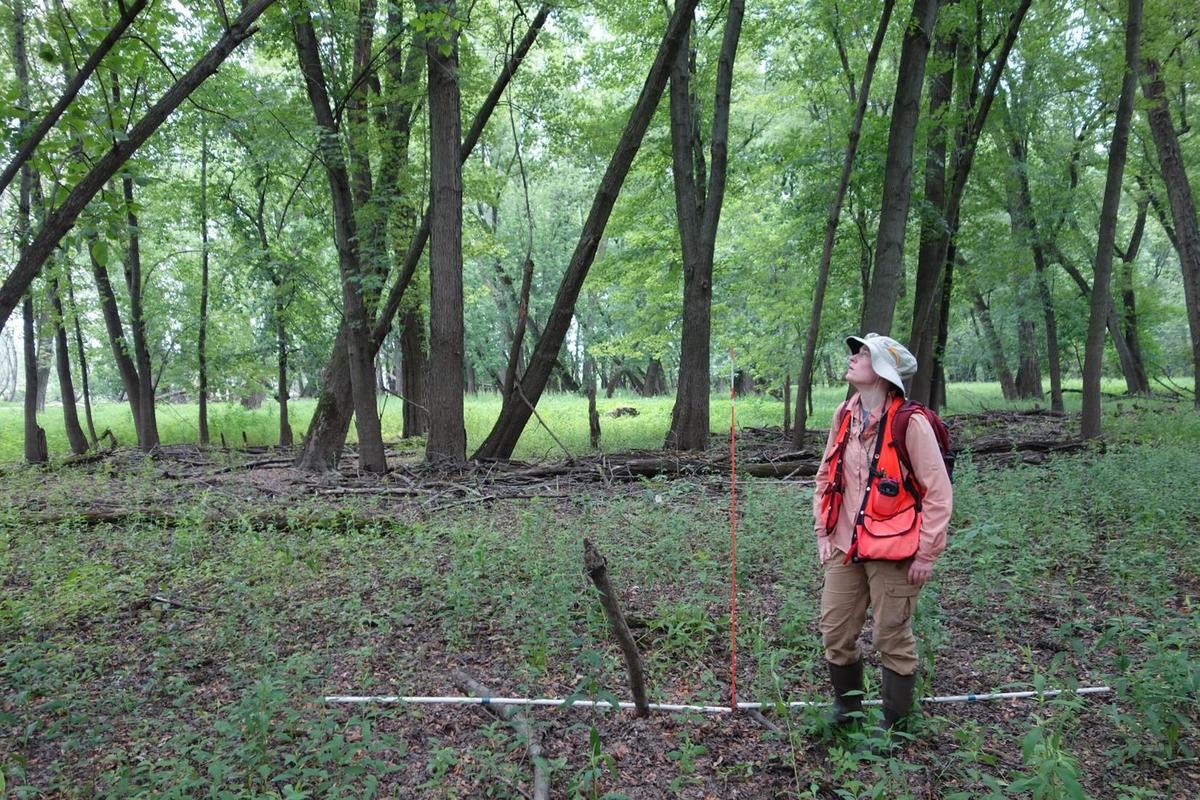Overview
This case study is a review of early results of an ongoing project to regenerate a mature bottomland hardwood stand in the Mississippi River floodplain system in southeastern Minnesota. A group selection (gap) harvest and artificial and natural regeneration have been accomplished so far. The site will be monitored as additional harvests and regeneration take place over time once regeneration becomes established in existing harvest gaps.
The native plant community silvicultural strategy on this site:
- Small gap: maintain a stand as would natural senescence, disease, beaver cutting, or physical battering to create small-gap habitat.
Much of the lowland hardwood forest acreage in this region is reaching biological maturity and is in need of active management to maintain forested condition. Yet it has proven very challenging to consistently regenerate lowland hardwood stands in the region. Two major challenges to successful regeneration of this area have been identified:
- Regular flooding inundation during the growing season most years. While there is excellent natural establishment of desirable seedlings (largely silver maple) in the spring and early summer of most years, they have been killed by almost annual growing season flooding inundation of a month or more.
- Heavy reed canarygrass competition in some of the more open areas. Thick patches of reed canarygrass provide extreme competition for moisture, light, and nutrients, choking out most other vegetation.
In addition to collecting tree seedling regeneration data following harvest, we also collected information on reed canarygrass competition to see if we could learn anything about its impacts on tree regeneration for this site.
Silviculture Objective(s)
- Maintain floodplain forest for wildlife habitat, ecological services, and economic reasons.
- Regenerate the mature portion of the stand to a young stand of similar composition.
- Improve the health and vigor of the younger portion of the stand.
- Improve timber quality and value.
Pre-treatment stand description and condition
Bottomland Hardwoods
Stand establishment and management history:
The study site is located in the floodplain of the Cannon and Mississippi Rivers. The site probably had a history of use as a wooded pasture and woodlot prior to the state obtaining the property from a private landowner in the 1970s.
Pre-treatment species composition:
The pre-harvest condition in 2011 was mature floodplain forest of varying densities. The site also had some small non-forested sections with annual floodplain vegetative cover, including sedges and reed canary grass, as well as some marshy inclusions.
Silver maple was by far the dominant overstory species in 2009. Also included were small components of cottonwood and green ash. Although they were not appraised for sale, there were also very small, very scattered components of American elm, black willow and boxelder in the stand, as is common in FF68 NPC stands.
Table 1: Appraised sawtimber volume by species in 2009 in the 24 acre treatment area.
|
Species |
Volume (MBF) |
|
Silver Maple |
41.98 |
|
Cottonwood |
7.23 |
|
Green Ash |
1.00 |
|
Total |
50.21 |

Figure 1: Michelle Martin takes a regeneration plot in a small gap harvest in spring 2021.
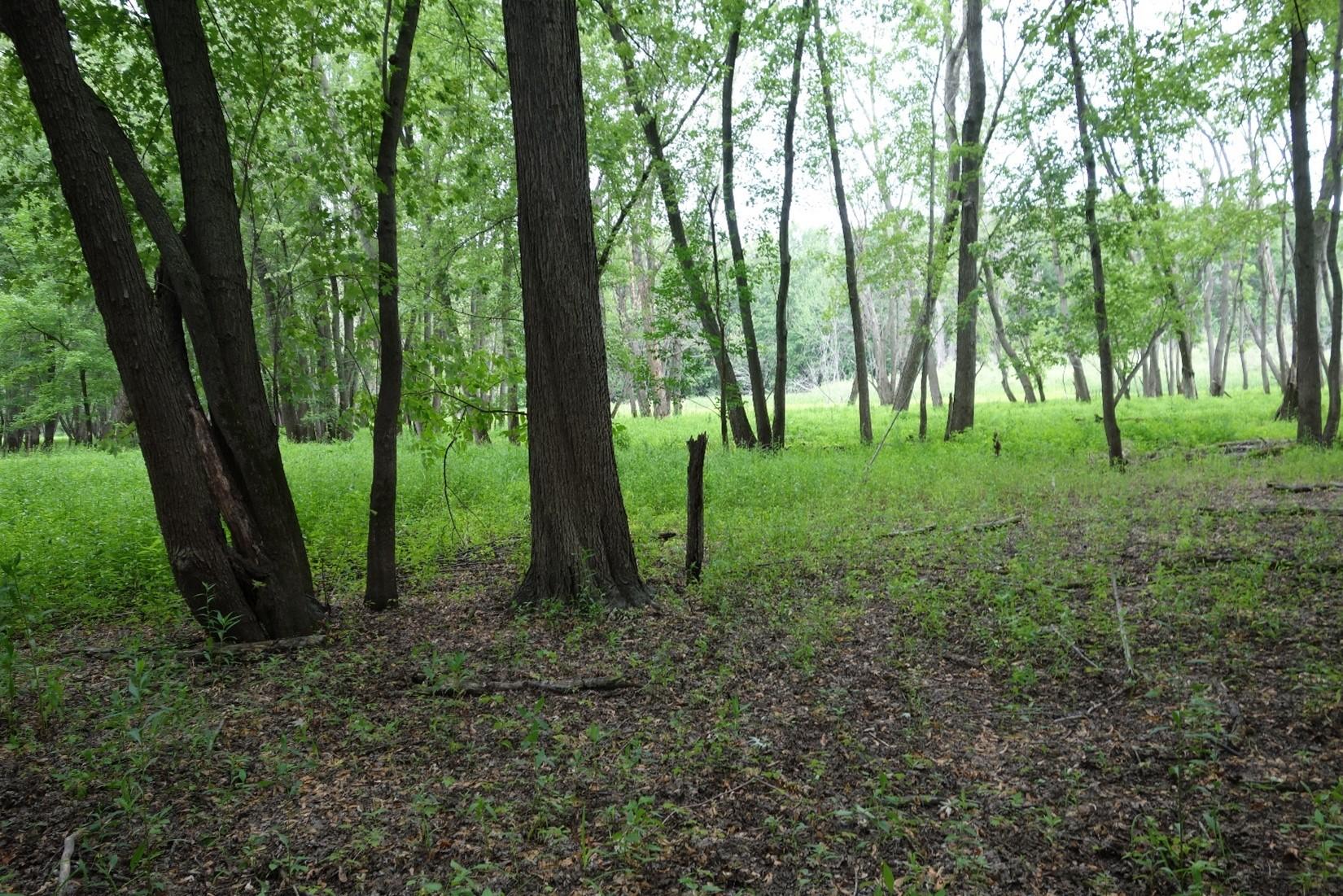
Figure 2: Forested conditions in an unharvested portion of the stand.

Figure 3: 2018 color aerial photo showing harvest gap locations.
Pre-treatment forest health issues:
Emerald ash borer. Emerald ash borer damage is found throughout the floodplain forests in the region. Ash is not a preferred species for regenerating the site.
Dutch elm disease. Elm is easily established on these types of sites but is killed by Dutch elm disease, usually before it reaches 8 inches diameter at breast height (DBH).
Landowner objectives/situation:
While specific objectives vary from parcel to parcel, lands under the administration of DNR-Forestry are managed in alignment with Section Forest Resource Management Plans (SFRMP) to ensure that state forest management activities meet statewide goals for ecological protection, wildlife habitat, timber production, and cultural/recreational values. The DNR assembles teams from the Divisions of Forestry, Fish & Wildlife, and Ecological & Water Resources who work with partners and the public to develop SFRMPs.
Specific objectives for this site and surrounding area are excerpted from the document “Blufflands/Rochester Plateau Subsection Forest Resource Management Planning ADDENDUM: Vermillion Bottoms and Lower Cannon River Area High Biodiversity Area Management Plan – December 2002”:
Maintain and regenerate native plant communities and the plant and animal species that reside in the area. The intent is to have timber age classes spatially distributed to provide habitat both now and in the future for adapted flora and fauna to survive in this area. Processes that mimic the disturbances that helped to establish and maintain these communities will be used to achieve this goal.
The goals of biodiversity protection, timber management, recreation, and wildlife management will all be included in management decisions to achieve this goal. As new research or management techniques become available, they may be incorporated into management practices prescribed in this plan to achieve the long-range goals.
Silviculture Prescription
The following series of treatments were implemented:
|
Date and Treatment |
Description |
Acres Treated |
|
2009 - Silvicultural assessment |
Assessment to determine silvicultural strategies to maintain, improve and regenerate the stand |
24 |
|
Spring 2010 - Underplanting |
Pre-harvest underplant a diverse mix of species that are suited to the site with available planting stock to supplement expected natural regeneration. Plant in portions of the stand with harvest gaps, but also across the entire site. Plant the following species:
|
30 |
|
2011-2012 - Group selection (gap) harvest |
Open the forest floor to sunlight for natural regeneration to become established, and release of underplanted species while minimizing hydrological alteration and reed canarygrass introduction. 23 gaps of 1/10th to 1/4 acre in size had all trees harvested within each gap. The harvest areas were spread throughout the site, but were concentrated in places with existing natural openings (Figure 3). |
Gaps totaling 4 acres |
|
Spring 2012 - Planting |
Planted 1,000 cottonwood and 2,000 swamp white oak |
24 |
|
August 2013 - Planted late due to prolonged flooding |
Planted 36 Dutch Elm Disease resistant elms per plot on 21 of the gaps as a field trial. |
2.5 |
|
August 2013 - Browse Protection |
Applied deer repellent (probably Plantskydd) to the DED resistant elms at time of planting. |
2.5 |
What actually happened during the treatment
The planned spring 2013 planting occurred in later in the growing season due to the site being underwater until August. Other treatments proceeded largely as planned.
Post-treatment assessment
The regeneration goal within the gaps is to establish an adequate amount of “free-to-grow” desirable regeneration. Free-to-grow can be defined as regeneration having reached a size and healthy condition where it can recruit to larger size classes without silvicultural assistance. For many species the terminal bud must be above browse height. We are hoping to establish adequate numbers of desirable regeneration large enough to withstand some growing season flooding before another harvest.
Regeneration data includes both the harvested gaps, and the unharvested areas of the stand.
Harvested gaps
In spring 2021 we completed 13 data plots in gap areas to assess the regeneration density and frequency of tree seedlings and competing ground vegetation. Figure 4 shows regeneration data and Figure 9 shows plot locations.

Figure 4: Regeneration density in harvested gaps by species, size class, and plot frequency.

Figure 5: Regeneration density in unharvested area by species, size class, and plot frequency.
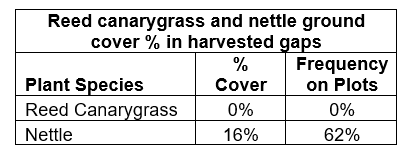
Figure 6: Reed canarygrass and nettle ground cover percentage and plot frequency in harvested gaps.
Regeneration
3 take aways from the post treatment assessment are:
1) Results 10 growing seasons after the gap harvest and planting treatment indicate there is no regeneration in the harvested gaps large enough to be considered “free-to-grow”.
2) However, there are more silver maple seedlings over a foot tall in the harvested gaps compared to the unharvested area (Figure 4 for harvest gap data and Figure 5 for unharvested area data). Most of these were between 1 and 2 feet in height (so not yet free-to-grow), but clearly, they have survived for more than one year. This gives hope that if the next few years do not have long summer flooding inundation conditions, some of these seedlings may become tall enough to be considered free-to-grow. We will continue to monitor the site closely to see how the regeneration progresses.
3) As is common if FFs68 forests, there are large numbers of silver maple regenerants under a foot tall (3,900/acre - Figure 4). These are not tall enough to withstand long summer flooding inundation.
For perspective on regeneration height and growth, we note that in ideal growing conditions of full sunlight and no competing vegetation in a plantation, 5-year-old silver maple in southern Ontario averaged 12.5 ft. in height after five growing seasons. With no site preparation, the average height of trees of the same age was only 1.6 ft. (US Department of Agriculture, Forest Service, Agriculture Handbook 654,1990).
Silver maple regeneration and reed canary grass competition
We estimated percentage of reed canarygrass cover for each of our harvest gap plots (Figure 6). Most surprisingly we observed no reed canary grass cover in the harvested gaps. Clearly, reed canarygrass has not spread or been an impediment to regeneration up to this point.
Other herbaceous competition
As shown in Figure 6, nettle ground cover averaged about 16%, and is present on approximately 1/3 of plots (62%) in harvest gaps. It is a strong competitor with tree seedlings in at least one of the gaps, but it is not a significant threat in most of the harvested area.
Probable causes of regeneration inadequacy
We think there are 2 main causes of regeneration inadequacy to this point – regular lengthy growing-season flooding inundation, and insufficient light reaching the forest floor.
Lengthy periods of summer flooding inundation. The frequency and duration of floodwaters in the Mississippi and Cannon River bottoms is a significant reality for land managers. While larger species like silver maple can withstand considerable growing season flooding, seedlings that are not tall enough to remain above the flood waters will die during prolonged growing season inundation periods.
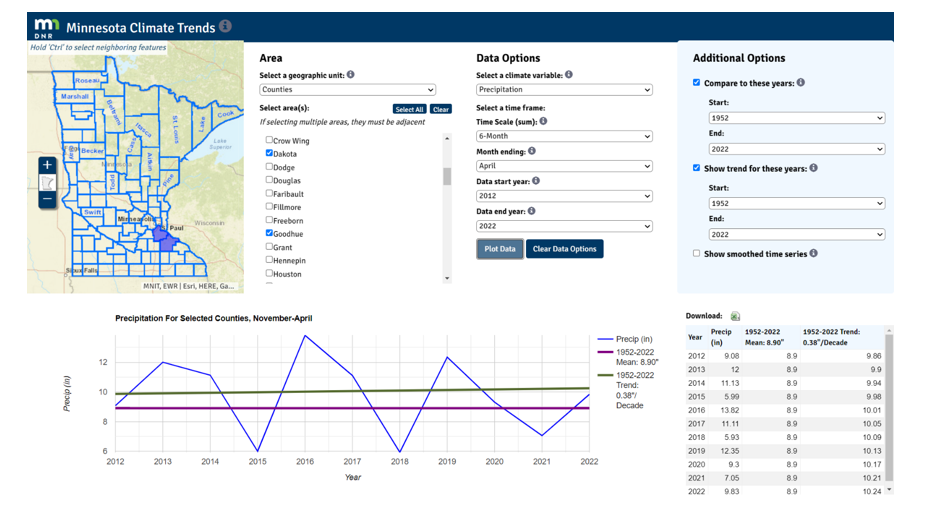
Figure 7: 2012-2022 growing season precipitation data for Dakota and Goodhue counties.
Figure 7 shows mostly wetter local growing seasons compared to long-term averages. Until recently (2020-2022), there have not been 2 or more consecutive years of near normal to below normal growing season precipitation that would enable seedlings to grow large enough to withstand flooding. In 2012-2019 the study site was under water for significant portions of growing seasons in most years. As a result, most small seedlings died.
Light conditions at forest floor inadequate. One of the silvicultural objectives is to maintain habitat and avoid major impacts to the site such as disruption to the water table that may occur by removing most of the overstory trees, so the harvest gaps were quite small. However, it is possible the1/10-to-1/4-acre harvest gaps might be too small to provide adequate light conditions and growing space for desired shade intolerant species.

Figure 8: Percent estimate and category for other herbaceous ground cover in harvested gaps.
Unharvested portion of stand
The species composition in the unharvested portion of the stand is consistent with typical FFs68 mature forests.
We share one potentially important observation from one of our plots in the unharvested portion of the stand which had a dominant cottonwood overstory rather than silver maple: in the understory we found 3-5” dbh silver maple saplings. This was the only plot in the entire study site (both harvest gaps and unharvested area) where we found 3” to 5” DBH silver maple regeneration.
While this is only one plot worth of data, it still raises at least 3 questions of why here and nowhere else?
1. Is the elevation relatively high, and therefore somewhat better-drained than the rest of the site? No, in fact it is a bit lower than average for the site. Average elevation of all plots is 205.4055 meters, and the elevation at the plot with larger silver maple regeneration and dominant cottonwood overstory is 205.3578 meters. See Digital Elevation Model (DEM) image in Figure 9 and elevation data in Figure 10.
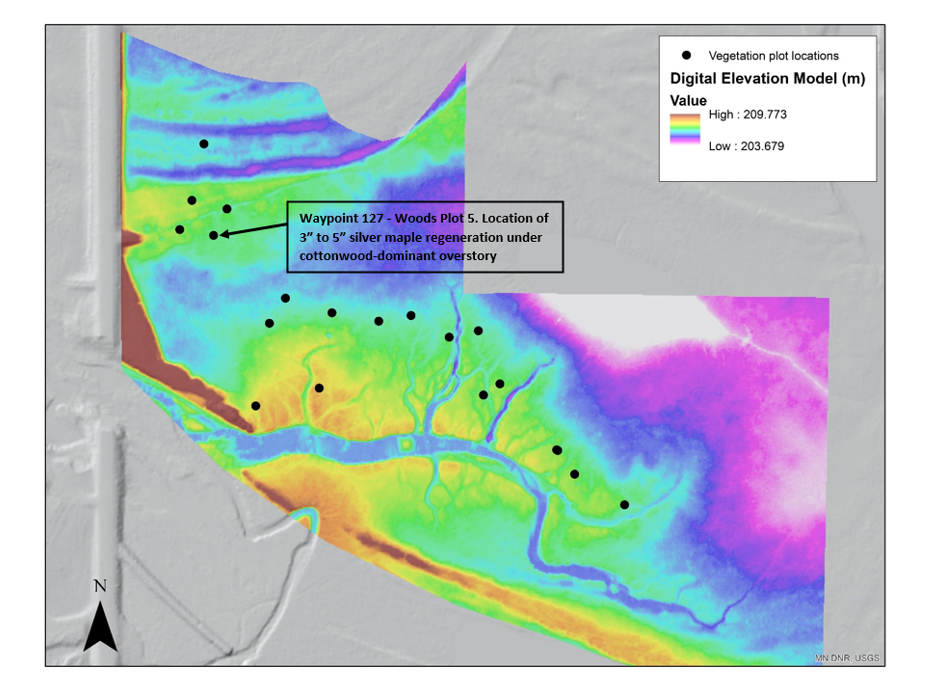
Figure 9: Digital elevation model image of case study area showing 2021 sample plot locations.
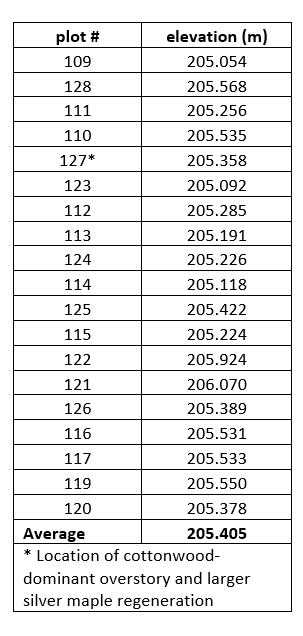
Figure 10: Elevation of 2021 data plots from digital elevation model.
2. Is cottonwood transpiration such that it is a superior hydrological “pump” that keeps adjacent ground drier than in silver maple dominated areas? This may be true, but even if there is a significant transpiration rate difference between cottonwood and silver maple, it would probably result in only a modest difference in soil moisture during non-flooded periods. Still, it is at least possible that this could have a positive impact on silver maple recruitment to larger size classes.
3. Are the understory light conditions beneath a cottonwood-dominated overstory different enough from a silver maple dominated overstory to facilitate recruitment of silver maple regeneration to larger size classes? In other words, is enough light getting to the understory to allow silver male regeneration to recruit to larger size classes, but not so much to allow competing nettles and other herbaceous competition to thrive? This (conditions of a bit more light under the cottonwood overstory) seems to us a far more likely explanation for superior recruitment success. We have noted similar observations for recruitment of red oak regeneration beneath aspen-dominated overstories. This, along with observations of impacts of light conditions at the edges of forest cover elsewhere, leads us to believe that a shelterwood regeneration strategy to mimic desirable light conditions would be a very worthwhile prescription to try in the future.
Reed canary grass and nettle competition impacts on silver maple regeneration
We estimated percentage of reed canarygrass and nettle cover for each of our unharvested area plots (Figure 12). We observed no nettle or reed canary grass on 83% of plots, and 1% cover on 17% of plots. Clearly, reed canarygrass and nettle have not been an impediment to regeneration in unharvested areas.
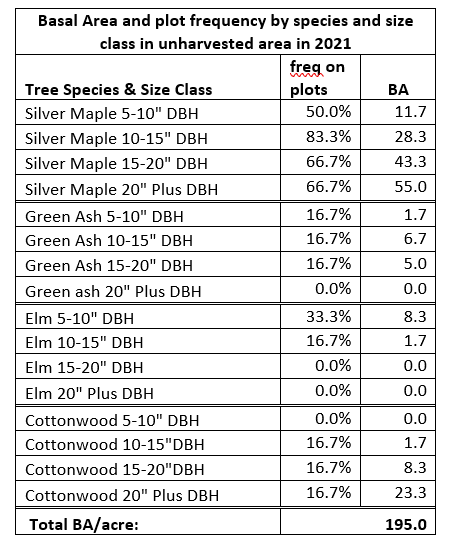
Figure 11: Basal area and plot frequency in the unharvested area by species and size class.
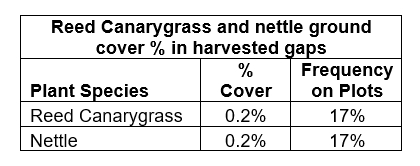
Figure 12: Reed canarygrass and nettle ground cover in unharvested area by percentage of total cover and plot frequency.

Figure 13: Percent estimate and category for other herbaceous ground cover in unharvested area.
Plans for future treatments
Shelterwood and/or expanding gap harvests and possibly additional artificial regeneration as regeneration becomes established in existing gaps.
Costs and economic considerations
Costs
2010 underplanting: $5,627 ($187/acre - 2010 dollars)
2012-2013 planting: $ 912 ($38/acre - 2012 dollars)
Revenue
Timber sale revenue $ 4,018 ($1,004/acre - 2011 dollars)
Other notes
We gratefully acknowledge the valuable review and editing assistance of MNDNR’s State Lands Program Supervisor Paul Dubuque.
This case study was developed with support from the United States Department of Agriculture's National Institute for Food and Agriculture, Renewable Resources Extension Act. Project #2021-46401-35956, principal investigator Eli Sagor, University of Minnesota.
Climate Adaptation Considerations
Impacts of a wetter climate
The wetter climate of the last 35 years has resulted in a more challenging environment for regenerating Mississippi and Vermillion River floodplain forests. Floodwater inundation in this area during the growing season has, on average, been greater and more frequent than in the decades preceding the 1980s. The year-round precipitation and growing season precipitation average is about 3 inches higher in the last 35 years than in the preceding 35 years. This is not only true for Goodhue County, but collectively for all Minnesota’s Mississippi River Counties in the region (Minnesota Climate Trends, 2022).
Summary / lessons learned / additional thoughts
We think there are 2 main causes of regeneration inadequacy to this point – long growing-season flooding inundations, and insufficient light reaching the forest floor because the harvest gaps were a bit too small.
The region and site have experienced higher than average growing season flooding inundation since project initiation in 2010
Until recently (2020-2022), there have not been 2 or more consecutive years of near normal to below normal growing season precipitation that would enable seedlings to grow large enough to withstand flooding. In 2012-2019 the study site was under water for significant portions of growing seasons in most years. As a result, most small seedlings died.
The current harvest gap sizes might have been too small
We wanted to be very careful to avoid major hydrological and habitat impacts to the site, so we kept harvest gap size quite small. However, in hindsight we think our gaps may have been a bit too small to provide adequate sunlight for adequate shade-intolerant desirable seedling growth.
We offer several additional observations about regeneration on this site below:
Reed canary grass competition was not a major impediment to silver maple regeneration success on this site
Reed canary grass can be a major impediment to silver maple regeneration on some other bottomland sites, however, that is not the case on this site. We were surprised to find no reed canarygrass in harvested gaps. As of 2021 it has not expanded further since harvest took place.
Elevation impacts on regeneration
We used Lidar data to see if we could learn anything useful about whether regeneration success might be related to changes in elevation (Figure 9). We don’t think we have enough regeneration established on the site yet to draw any solid conclusions. However, the elevation was relatively low on the only plot where we found larger (3” to 5” DBH) silver maple regeneration.
A shelterwood harvest might be a good regeneration option for our next step
Based on some observations in this study, we think a shelterwood harvest to provide desirable light conditions to release advance regeneration might be a good option to try for our next regeneration entry. The site has good access and a good volume of adequate quality timber to facilitate a shelterwood prescription. An expanding gap harvest design would also be an option.
Patience and persistence are required to regenerate Southern Floodplain Forest sites
Based on our findings on this and several other case study sites in the region, we suggest that patience and persistence are critical for successful regeneration in the Mississippi River bottomland hardwoods system. We plan on frequent regeneration checks and adaptive management efforts until trees reach the “free to grow” stage.
We think the biggest challenge by far is in getting young seedlings tall enough to withstand growing season flooding. Regeneration efforts must be targeted and persistent to take advantage of two or more consecutive years without major summer flooding inundation to ensure seedlings grow tall enough to withstand future summer wet periods. Unfortunately, we can’t know ahead of time when those consecutive normal or drier summer years might happen.
Seedling size to withstand summer flooding will vary due to site conditions. However, at a minimum, they need to be over 2 feet tall, and maybe even in some cases 6 feet plus, before we consider them “free-to-grow”.
Development of consistent regeneration methods for lowland hardwood stands in the Mississippi River floodplain is a significant challenge in need of continued attention
We will continue to examine impacts of harvest and regeneration methods, soils, elevation, and reed canary grass competition in future studies.
